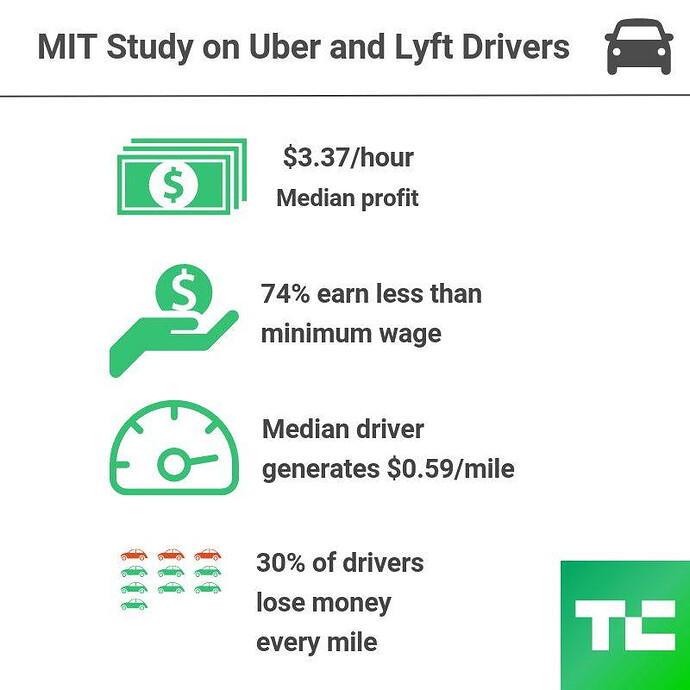In a recent MIT ground shaking survey, most of all Uber and Lyft drivers only take home a net amount of $3.37 per hour. This means that most rideshare drivers earn well below State minimum, and in fact earn less than an illegal immigrant picking Oranges in California.
According to the research results, approximately 30% of all drivers are losing money, which means they don't make enough to cover their driving expenses and end up paying for driving other people.
This study was performed by researchers from the Massachusetts Institute of Technology (MIT), Center for Energy and Environmental Policy Research. They are; Stephen M. Zoepf, Stella Chen, Paa Adu and Gonzalo Pozo.
The survey covered 1,100 drivers who were interviewed by the researchers and provided them with their income figures. The answers included the type of car, the insurance, maintenance, gas and depreciation factors that were supported by accepted sites such as Kelley Blue Book, Edmunds and the Environmental Protection Agency (EPA).
According to the study, drivers earned around $0.59 per mile, while expenses were set around $0.30 per mile, this means that the net income was only $0.29 per mile driven. (Remember that Uber only pays for the actual miles driven while transporting a passenger – period 3 miles).
We also looked at recent studies and found: Uber Driver Pay Averages $11 - $15 Per Hour
Drivers earning the median amount of revenue are getting $0.59 per mile driven, researchers say, but expenses work out to $0.30 per mile, meaning a driver makes a median profit of $0.29 for each mile.
Uber stated I response to the paper, which shines a very bad light on their operations, that they believe the paper is flawed and that the methodology is incorrect. Uber went on to state that they would be happy to work together with the researchers to refine the methodology and reach correct results.
Many studies have been performed on driver's income, even in this forum (RFS) there are plenty of different articles attesting to how much a driver receives, and in one of our articles we found similar results as MIT. In fact, we found that most calculations take into account every possible expense but forget to include the monthly payments on the car loan, as well as the miles incurred for periods 1 & 2. When you add these key figures into the mix, you end up finding that most drivers are working for Uber and paying Uber for the privilege of driving for them.
Another finding in the MIT paper is the possibility that the IRS loses billions of tax dollars due to the IRS standard mileage rate deduction which is set at $0.54. Since most drivers use this basic calculation as their expense, rather than calculating their actual expenses, the income, based on MIT figures means that drivers only earn on average $0.045 per mile! 5 cents a mile income!
Another section of the paper also stated that according to their findings and assuming "If drivers are fully able to capitalize on these losses for tax purposes, 73.5% of an estimated U.S. market $4.8B in annual ride-hailing driver profit is untaxed."
80% of the surveyed drivers told the MIT researchers that they work less than 40 hours a week, this fact falls into place when comparing it to an NPR/Marist poll performed in January 2018, which showed that 20% of all US jobs are held by contract workers, and many of them hold more than one part-time job, making a mix of incomes.
It is also a proven fact from other studies that Uber and Lyft have very high driver turn over rates, where the vast majority only drive for under 3 months. Only 4-7% drive for over a year.
Another important fact to note is that Uber only introduced them in-app tipping from July last year, and it is still hidden under the rating screen, which makes it still an ineffective tool for immediate tipping.
To conclude this article, the report shows that while drivers have been battling for years to become employees of Uber, the reality of their status is basically how Uber will work when introducing the driverless car. Since according to this report, they pay drivers so little, that the income only covers, and sometimes only partially covers the expenses of driving. Which is what would be the case with the AV's, where Uber would only need to pay for car maintenance and cleaning.


 (They probably all spit in your food if you’re a regular anywhere.)
(They probably all spit in your food if you’re a regular anywhere.)